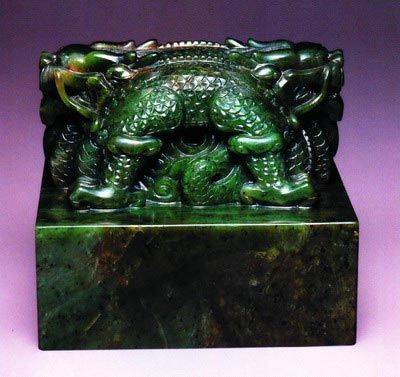Chinese art raises US$34 mln at London sale
Auction house Sotheby's broke its record for Chinese art sales on Wednesday.
The roughly six-hour auction of 343 Chinese ceramics and art works, including an 800-year-old vase and a dragon seal used by Emperor Jiaqing (1796-1820), realized a total value of 20.8 million pounds (US$34 million), nearly double the pre-sale estimate of 11 million pounds.
 |
|
The dragon seal used by Emperor Jiaqing (1796-1820) autioned at the Sotheby aution house, London, on May 12, 2011. |
This was almost US$1.5 million more than Sotheby's previous record in London of US$32.55 million, set three years ago. The outcome partly reflects rising interest in Chinese art works and antiques in the world auction market.
The auction house said every item in the sale on Wednesday had been "meticulously selected as an iconic example of its genre".
Most of the items on sale were antiques, with the oldest pieces including a jade axe dating back to the Neolithic period, which began in China around 12,000 years ago.
Fourteen of the 343 items were from a Japanese collection, including an "important and rare" 12th century "Ice Crackle Guan" vase from the Southern Song Dynasty (1127-1279).
At 2.2 million pounds, the vase, as expected, turned out to be the most expensive item on Wednesday.
"Guan", the official ware of the Southern Song court, is perhaps the most admirable and desirable of all Chinese ceramics.
"This vase came to Japan fairly recently," according to the auction house's catalogue.
"Chinese ceramics were imported to Japan ever since the Nara period (710-794) - in China in the Tang Dynasty (618-907).
"The immense spectrum of Song ceramics - unrepeated in the history of Chinese ceramics - fascinated Japanese collectors."
Another star of Wednesday's auction was an imperial Khotan jade dragon seal of Emperor Jiaqing in the Qing Dynasty (1644-1911). Khotan in Xinjiang is famous for its high-quality nephrite jade.
It was finally sold for 1.7 million pounds, more than its pre-sale estimate of 1.5 million.
Wednesday's auction in central London attracted quite a few Chinese bidders and buyers, as conversations in Mandarin and Chinese dialects such as Cantonese could be heard on the Sotheby's trading floor.
Competition between Chinese bidders contributed to the soaring price of some items.
A peachbloom-glazed washer, produced in the 19th century, was sold to a Chinese bidder for 24,000 pounds, about 10 times its pre-sale estimate of 2,500 pounds.
"Chinese buyers today have much more access to information about the world market and what excellent art pieces will be presented in auctions abroad," said Guan Yu, an art market analyst at the Beijing-based Artron Art Market Monitoring Center.
Those buyers are traveling across the world to purchase works of art not only because they can afford it, but also because they can find Chinese antiquities with sound provenance and important artistic value in sales rooms abroad, Guan said.
Sotheby's held its first auction of Chinese art in London in 1922. Sales are now held twice yearly in Hong Kong, New York, London and Paris, with an international team of specialists traveling the globe to bring some of the greatest masterpieces of Chinese art to the market.
There has been a rising interest in Chinese art pieces and antiques in the global auction market. A 300-year-old Chinese porcelain vase, made during the reign of Emperor Qianlong (1736-1796), was sold for 43 million pounds at an auction in London in November.
 0
0 







Go to Forum >>0 Comments